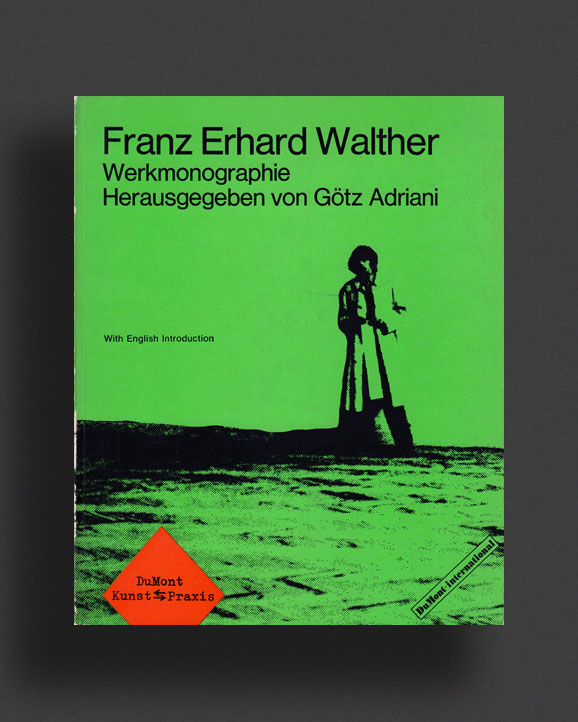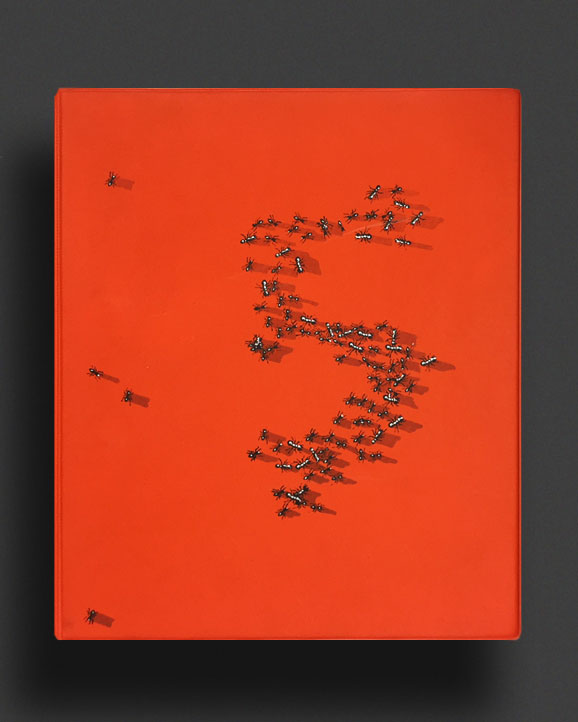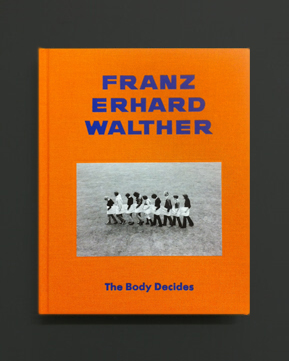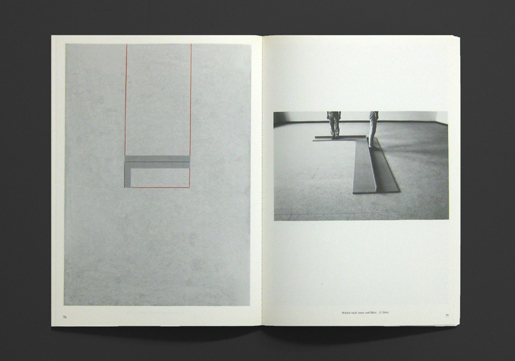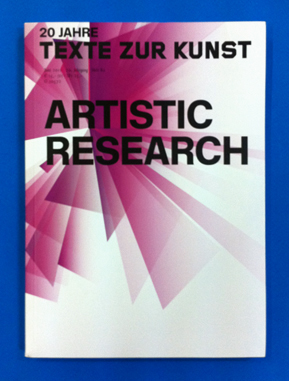(...less)
Scarce copy of the only edition of the most elaborately designed, and lowest circulated Documenta catalogue, conceived by curator Harald Szeemann to accompany the fifth edition of Documenta, a quinquennial contemporary art exhibition held in Kassel, Germany.
Subtitled "100 Days of Inquiry into Reality -- Today's Imagery," curated by the team of Harald Szeemann, Jean-Christophe Ammann and Arnold Bode, Documenta 5 followed a lineage of comprehensive shows documenting conceptually and minimally charged artworks curated by Szeemann including Live in Your Head (Kunsthalle Bern, 1969), and Happenings and Fluxus (Kunstverein, Köln), 1970. The largest, most expensive and most diverse of any exhibition anywhere, Documenta 5 was criticized in 1972 as being “bizarre…vulgar…sadistic” by art critic and essayist Hilton Kramer and “monstrous… overtly deranged” by art historian and art critic Barbara Rose, yet it still resonates today as one of the most important exhibitions in history. Featuring the works of over 170 artists and an equally expansive variety of materials and subjects drawn from popular cultural materials, architecture, science fiction, kitsch objects, film, advertising, children's art, etc. in addition to the more anticipated international survey of new painting and sculpture - Documenta 5 valiantly attempted to bridge the gap between art, culture, science and the broader society. This massive tome is housed in the iconic orange vinyl-covered, two-ring binder screen printed with the famous ant design by Edward Ruscha. The binder holds a tabbed index of illustrated artist's pages and associated texts and material, largely in German, but also many in English. All registers are present apart from the usual missing 19-25 which were not directly integrated into the catalogue and had to be ordered by the visitor separately to become their own contribution. This very complete copy also includes the additional 80 page, hole-punched Documenta 5 guide book, with floor plans, complete listing of exhibited artworks, list of exhibitions, bibliography, and many gallery, museum and other related advertisements. More than a catalogue, this publication is a piece of art history in itself.
Includes artists: Vito Acconci, Vincenzo Agnetti, Peter Alexander, John de Andrea, Giovanni Anselmo, Arbeitszeit, Archigram, Chuck Arnoldi, Art & Language, Richard Artschwager, Michael Ashkin, John Baldessari, Robert Barry, Georg Baselitz, Lothar Baumgarten, Robert Bechtle, Gottfried Bechtold, Bernd & Hilla Becher, Joseph Beuys, Karl Oskar Blase, Mel Bochner, Alighiero Boetti, Christian Boltanski, Claudio Bravo, George Brecht, K.P. Brehmer, Marcel Broodthaers, Stanley Brouwn, Günter Brus, Daniel Buren, Victor Burgin, Michael Buthe, James Lee Byars, Pier Paolo Calzolari, Luciano Castelli, Christo and Jeanne-Claude, Chuck Close, Tony Conrad, Ron Cooper, Bill Copley, Joseph Cornell, Robert Cottingham, Paul Cotton, Hanne Darboven, Walter De Maria, David Deutsch, Jan Dibbets, Herbert Distel, Gino de Dominicis, Marcel Duchamp, John Dugger, Don Eddy, Franz Eggenschwiler, Ger van Elk, Richard Estes, Luciano Fabro, John C. Fernie, Robert Filliou, Jud Fine, Joel Fisher, Terry Fox, Howard Fried, Hamish Fulton, Franz Gertsch, Gilbert & George, Ralph Goings, Hubert Gojowczyk, Dan Graham, Walter Grasskamp, Nancy Graves, Hans Haacke, Duane Hanson, Guy Harloff, Michael Harvey, Haus-Rucker-Co, Auguste Herbin, Eva Hesse, Rebecca Horn, Jean Olivier Hucleux, Douglas Huebler, Jörg Immendorff, Will Insley, Rolf Iseli, Ken Jacobs, Neil Jenney, Alfred Jensen, Jasper Johns, Joan Jonas, Max G. Kaminski, Howard Kanovitz, Edward Kienholz, Imi Knoebel, Christof Kohlhofer, Jannis Kounellis, Tom Kovachevich, Piotr Kowalski, David Lamelas, Barry Le Va, Jean LeGac, Alfred Leslie, Sol LeWitt, Richard Long, Ingeborg Luscher, Inge Mahn, Robert Mangold, Brice Marden, Agnes Martin, Etienne Martin, Richard McLean, David Medalla, Fernando Melani, Jim Melchert, Mario Merz, Gustav Metzger, Bernd Minnich, Malcolm Morley, Ed Moses, Bruce Nauman, Hermann Nitsch, Claes Oldenburg, Yoko Ono, Dennis Oppenheim, Blinky Palermo, Panamarenko, Giulio Paolini, A.R. Penck, Giuseppe Penone, Vettor Pisani, Sigmar Polke, Stephen Posen, Markus Raetz, Arnulf Rainer, Gerhard Richter, Klaus Rinke, Dorothea Rockburne, Peter Roehr, Allen Ruppersberg, Edward Ruscha, Reiner Ruthenbeck, Ulrich Ruckriem, Robert Ryman, John Salt, Salvo, Lucas Samaras, Paul Sarkisian, Jean-Frederic Schnyder, Ben Schonzeit, Werner Schroeter, HA Schult, Rudolf Schwarzkogler, Fritz Schwegler, Richard Serra, Paul Sharits, Allan Shields, Katharina Sieverding, Robert Smithson, Michael Snow, Keith Sonnier, Klaus Staeck, Paul Staiger, Jorge Stever, Robert Strubin, Paul Thek, Wayne Thiebaud, Andre Thomkins, David Tremlett, Richard Tuttle, Ben Vautier, W + B Hein, Franz Erhard Walther, Robert Watts, William Wegman, Lawrence Weiner, John Wesley, H.C. Westermann, William Wiley, Rolf Winnewisser, Tom Wudl, Klaus Wyborny, La Monte Young, Peter Young, Gilberto Zorio.
Catalogue also includes Bob Projansky and Seth Siegelaub's "The Artist's Reserved Rights Transfer and Sale Agreement." This "Agreement form has been drafted by Bob Projansky, a New York lawyer, after my [Siegelaub] extensive discussions and correspondence with over 500 artists, dealers, lawyers, collectors, museum people, critics and other concerned people involved in the day-to-day workings of the international art world. The Agreement has been designed to remedy some generally acknowledged inequities in the art world, particularly artists' lack of control over the use of their work and participation in its economics after they no longer own it. The Agreement for has been written with special awareness of the current ordinary practices and economic realitites of the art world, particularly its private, cash and informal nature, with careful regard for the interests and motives of all concerned. It is expected to be the standard form for the transfer and sale of all contemporary art, and has been made as fair, simple and useful as possible. It can be used either as presented here or slightly altered to fit your specific situation. If the following information does not answer all your questions consult your attorney." -- from Agreement's cover. Copies of the contract are individually included in English, Germany, and French editions.
Very Good, complete (as issued) copy. Very minor wear.
File under:
Vito Acconci
Vincenzo Agnetti
Peter Alexander
John de Andrea
Giovanni Anselmo
Arbeitszeit
Archigram
Chuck Arnoldi
Art & Language
Richard Artschwager
Michael Ashkin
John Baldessari
Robert Barry
Georg Baselitz
Lothar Baumgarten
Robert Bechtle
Gottfried Bechtold
Joseph Beuys
Karl Oskar Blase
Mel Bochner
Alighiero Boetti
Christian Boltanski
Claudio Bravo
George Brecht
Marcel Broodthaers
Stanley Brouwn
Günter Brus
Daniel Buren
Victor Burgin
Michael Buthe
James Lee Byars
Pier Paolo Calzolari
Luciano Castelli
Chuck Close
Tony Conrad
Ron Cooper
Bill Copley
Joseph Cornell
Robert Cottingham
Paul Cotton
Hanne Darboven
Walter De Maria
David Deutsch
Jan Dibbets
Herbert Distel
Gino de Dominicis
Marcel Duchamp
John Dugger
Don Eddy
Franz Eggenschwiler
Ger van Elk
Richard Estes
Luciano Fabro
John C. Fernie
Robert Filliou
Jud Fine
Joel Fisher
Terry Fox
Howard Fried
Hamish Fulton
Franz Gertsch
Gilbert & George
Ralph Goings
Hubert Gojowczyk
Dan Graham
Walter Grasskamp
Nancy Graves
Hans Haacke
Duane Hanson
Guy Harloff
Michael Harvey
Haus-Rucker-Co
Auguste Herbin
Eva Hesse
Rebecca Horn
Jean Olivier Hucleux
Douglas Huebler
Jörg Immendorff
Will Insley
Rolf Iseli
Ken Jacobs
Neil Jenney
Alfred Jensen
Jasper Johns
Joan Jonas
Max G. Kaminski
Howard Kanovitz
Edward Kienholz
Imi Knoebel
Christof Kohlhofer
Jannis Kounellis
H.C. Westermann
William Wiley
Rolf Winnewisser
Tom Wudl
Klaus Wyborny
La Monte Young
Peter Young
Gilberto Zorio
Franz Erhard Walther
Robert Watts
William Wegman
Lawrence Weiner
John Wesley
Tom Kovachevich
Piotr Kowalski
David Lamelas
Barry Le Va
Jean LeGac
Alfred Leslie
Richard Long
Ingeborg Lüscher
Inge Mahn
Brice Marden
Yoko Ono
Dennis Oppenheim
Blinky Palermo
Panamarenko
Giulio Paolini
A.R. Penck
Giuseppe Penone
Vettor Pisani
Sigmar Polke
Stephen Posen
Markus Raetz
Arnulf Rainer
Gerhard Richter
Klaus Rinke
Dorothea Rockburne
Peter Roehr
Allen Ruppersberg
Edward Ruscha
Reiner Ruthenbeck
Ulrich Ruckriem
Robert Ryman
John Salt
Salvo
Lucas Samaras
Paul Sarkisian
Jean-Frederic Schnyder
Ben Schonzeit
Werner Schroeter
HA Schult
Rudolf Schwarzkogler
Fritz Schwegler
Richard Serra
Paul Sharits
Allan Shields
Katharina Sieverding
Robert Smithson
Michael Snow
Keith Sonnier
Klaus Staeck
Paul Staiger
Jorge Stever
Robert Strubin
Paul Thek
Malcolm Morley
Ed Moses
Bruce Nauman
Hermann Nitsch
Claes Oldenburg
Agnes Martin
Etienne-Martin
Richard McLean
David Medalla
Fernando Melani
Bernd and Hilla Becher
K. P. Brehmer
Christo & Jeanne-Claude
Seth Siegelaub
Harald Szeemann
Jean-Christophe Ammann
Bob Projansky
Arnold Bode
documenta / Kassel
Art
Group Shows / Collections
Out-of-print / Rare
Objects / Ephemera / A/V
Arte Povera
Conceptual Art
Feminism
Theory / Essay
Architecture / Interior
Performance / Dance / Theater
Fluxus
Dada
Curatorial
Film / Video
Minimal Art
Nouveau Réalisme / Zero / Kinetic
Painting
Photography
Pop Art
Sculpture / Installation
Counterculture
Art Brut / Folk / Visionary / Fantastic
























































































































































